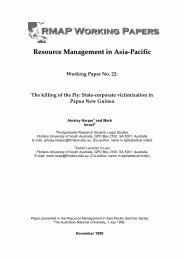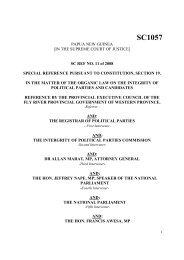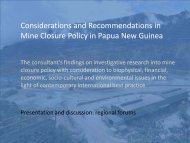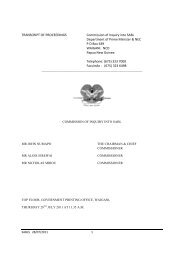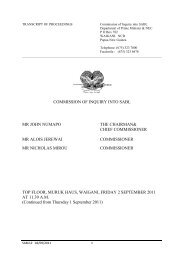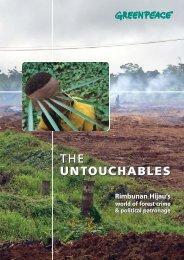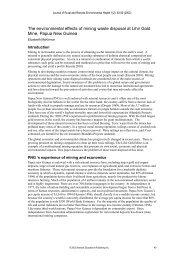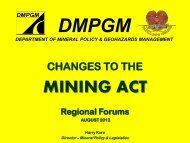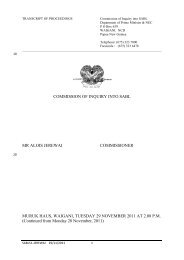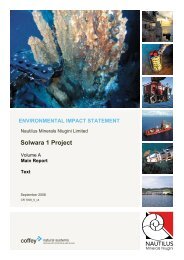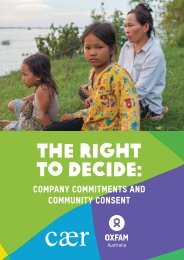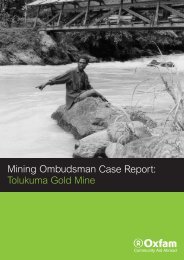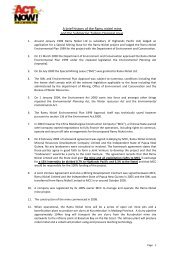Fishy business. The Social Impact of SST.pdf - Act Now!
Fishy business. The Social Impact of SST.pdf - Act Now!
Fishy business. The Social Impact of SST.pdf - Act Now!
Create successful ePaper yourself
Turn your PDF publications into a flip-book with our unique Google optimized e-Paper software.
public figures who had seen RD Tuna in Madang, and become aware <strong>of</strong> its labour, sanitationand pollution issues, not to mention its court cases with the landowners, were confident thatlight industry could be done differently, and that the Sepik people could have it their way, fortheir benefit. Indeed, <strong>SST</strong> did learn from RD’s mistakes, most notably in its engineering anddesign, both <strong>of</strong> which are proudly touted to be state <strong>of</strong> the art. Even its odour filtration system(because, after all, every fish factory has an odour) is amongst the best in the world. Some <strong>of</strong>RD’s own management team, and some floor workers as well, also came over from Madang tojoin the new team. In these ways, <strong>SST</strong> has been ahead <strong>of</strong> the curve in PNG, at least for thefishing industry: having seen the processing precedents, they were bound to make a better go <strong>of</strong>it.Some <strong>of</strong> the management team originally hired out <strong>of</strong> Port Moresby were alumni <strong>of</strong> other largeresource development projects in PNG, like Ok Tedi, and others had certainly experiencedsmaller projects (from running water to piggeries) being introduced to peri-urban and ruralsettings. Undoubtedly a lot <strong>of</strong> PNG-specific management information is under contract to <strong>SST</strong>,even if it’s not been utilized. Perhaps the plans were drawn against fishing industry standardsonly, perhaps they were concretized before Papua New Guineans could have a say. In eithercase, the management style and ethos <strong>of</strong> <strong>SST</strong> is entirely esoteric to the PNG context and has yetto engage some <strong>of</strong> the critical issues that most developers grapple with in this country, namelylandowner rights, the ‘living’ wage, community relations, and financial transparency.Nancy Sullivan Ltd., was engaged by HELP Resources, Wewak, to undertake a social impactstudy <strong>of</strong> the factory, as part <strong>of</strong> a training program in ethnographic research tools for the NGO’scommunity volunteers. We arrived late June (2005) and spent ten days in workshop sessionswith roughly 40 volunteer-participants. We then sent them out on two large studies, one <strong>of</strong>vanilla, the other <strong>of</strong> <strong>SST</strong>. Ultimately about 8 dedicated volunteers joined a team <strong>of</strong> 6 NancySullivan Ltd. employees (including the company Director) in a town-based study <strong>of</strong> the loiningplant and its workers, its <strong>business</strong> pr<strong>of</strong>ile, its history and general social impact on Wewak town.Our company previously authored a social impact report on RD Tuna in Madang, called TinpisMaror (for which Thomas Warr was a Principal Investigator). In total, we spent a monthgathering information and interviews from representatives groups and individuals. Some <strong>of</strong>these interviews are excerpted here, some provide redundant verification <strong>of</strong> facts and opinions,and many more not represented here have formed the basis <strong>of</strong> our understanding <strong>of</strong> <strong>SST</strong>. Anytypos or inaccuracies are our own.<strong>The</strong> task before us began as a social impact report on the South Seas Tuna loining factory inWewak. In the end, however, it grew to become an economic analysis <strong>of</strong> Wewak’s <strong>business</strong>climate at present. We found that it was impossible to isolate the factory from the <strong>business</strong>community at large in order to conduct a true social impact study. On the one hand, we might beable to talk about the factory as a discrete <strong>business</strong> entity, whose owners and operators wereostensibly disassociated from other commercial proposals and projects surrounding it. But onthe other hand, this would inadequately represent how very opaque and layered the climate <strong>of</strong>commerce is at present in Wewak, and so for this reason we have opened Pandora’s box slightlyto reveal how typical, how <strong>of</strong> a piece and compatible are the conditions and structures <strong>of</strong> SouthSeas Tuna in the present <strong>business</strong> environment in Wewak and the East Sepik Province moregenerally.South Seas Tuna is one <strong>of</strong> very few fish production plants in PNG today, and these are amongstthe first light industry factories to be introduced to the commercial sector as part <strong>of</strong> adownstream processing emphasis on the part <strong>of</strong> <strong>The</strong> National government. In Wewak’s case, thetuna now being loined at <strong>SST</strong> would otherwise have been shipped to similar plants in the20



